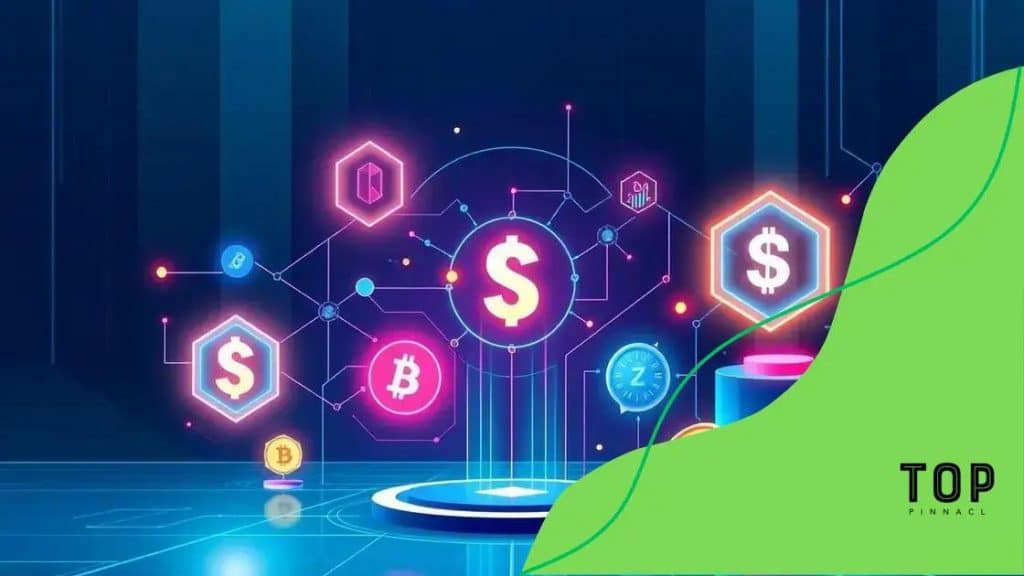DeFi lending platforms: unlock your financial potential

DeFi lending allows users to lend and borrow cryptocurrencies through decentralized platforms, utilizing smart contracts for transactions while offering opportunities for high returns and increased participation from institutional investors.
DeFi lending platforms are reshaping the financial landscape, making it easier for individuals to borrow and lend without traditional banks. Have you ever wondered how these platforms can change your financial future? Let’s dive in!
Understanding DeFi lending platforms
Understanding DeFi lending platforms is crucial in today’s financial world. These platforms leverage blockchain technology to allow users to lend and borrow without traditional banks. Imagine a system where you have complete control over your assets with lower fees and faster transactions.
What Are DeFi Lending Platforms?
DeFi lending platforms are decentralized applications that enable users to borrow or lend cryptocurrencies. They eliminate intermediaries, giving users more freedom and flexibility. Users can provide liquidity to the platform and earn interest on their assets. This process creates a more direct and engaging financial experience.
How Do They Work?
The working of these platforms is based on smart contracts. A smart contract is a self-executing contract with the agreement directly written into code. When you lend cryptocurrency to someone, the smart contract handles all transactions automatically, ensuring both parties fulfill their agreed responsibilities.
- Liquidity Pools: Users deposit their assets into pools to provide liquidity for borrowers.
- Interest Rates: Rates fluctuate according to demand and supply, affecting how much you earn or pay.
- Collateral: Borrowers must provide collateral, which can significantly reduce default risk.
- Access: Anyone with a digital wallet can participate, making it widely accessible.
Benefits of DeFi Lending
One of the major advantages is the potential for high returns. Users can earn significantly more through DeFi lending compared to traditional savings accounts. Additionally, there’s increased transparency due to the public nature of blockchain, allowing users to verify the platform’s operations easily.
Security also improves with decentralization. Without a central authority, the chances of hacking become lower. Furthermore, users maintain ownership of their assets until they choose to lend them, reducing risks associated with traditional platforms.
In conclusion, DeFi lending platforms represent a modern shift in how individuals can engage with their finances. They offer exciting opportunities for innovation and financial independence, enabling anyone to access resources without relying on conventional banking systems.
Benefits of using DeFi for lending
Exploring the benefits of using DeFi for lending reveals many advantages that can enhance your financial strategy. Unlike traditional lending systems, DeFi platforms offer peer-to-peer transactions that streamline the borrowing and lending process. This change allows for more flexibility and efficiency in managing your assets.
High Returns
One of the standout points is the potential for high returns. Users lending their cryptocurrency can earn significantly higher interest rates compared to traditional banks. This feature attracts users looking to maximize their profits and grow their investments.
Accessibility
Another critical benefit is accessibility. Anyone with an internet connection can participate in DeFi lending. There are no geographical barriers or long application processes. This democratization of finance opens doors for many individuals who may have been excluded from traditional banking services.
- Low Fees: Many platforms charge minimal fees because they operate without intermediaries.
- Instant Transactions: The use of blockchain technology allows for quick transactions, often completed in a matter of minutes.
- Transparency: Users can view all transactions on the blockchain, providing a high level of trust.
- Ownership: Users maintain control of their assets, reducing risks associated with third-party services.
Security also plays a vital role in the conversation about DeFi lending. Since transactions are secured by blockchain technology, they are generally safer than traditional methods. Each transaction is recorded immutably, reducing the chance of fraud and misuse.
In addition to security and flexibility, the innovation of smart contracts increases efficiency. Smart contracts automate the lending process, ensuring that agreements are upheld without the need for intermediaries. This automation can significantly decrease operational costs and increase user satisfaction.
Overall, the advantages of leveraging DeFi for lending are clear, making it an appealing choice for anyone interested in modern finance.
How to participate in DeFi lending

Participating in DeFi lending is easier than ever, and it opens up many opportunities for earning. Essentially, it involves lending your assets to others in exchange for interest, all done in a decentralized manner.
Step 1: Choose a DeFi platform
The first step is selecting a trustworthy DeFi lending platform. Some popular options include platforms like Aave, Compound, and MakerDAO. Each platform has unique features, so it’s essential to do a bit of research to find the one that suits your needs best.
Step 2: Create a digital wallet
Next, you’ll need a digital wallet that supports the blockchain network used by the platform you’ve chosen. Wallets like MetaMask, Trust Wallet, and Coinbase Wallet are popular choices. Make sure to secure your wallet with a strong password and follow best practices to keep it safe.
- Verification: Some platforms may require you to verify your identity.
- Connect your wallet: Follow the platform’s instructions to connect your digital wallet.
- Understand fees: Review any transaction fees associated with lending your assets.
Once your wallet is set up and connected, you can deposit your assets into the chosen platform. This step involves transferring cryptocurrency from your wallet to the platform’s smart contract, which manages your assets. Be aware that you’ll need to select the specific asset you want to lend and check the prevailing interest rates.
After depositing, your assets will be available for borrowers. As borrowers take loans, you will start earning interest based on the terms set by the platform. To ensure a good experience, it’s wise to monitor your investment regularly and be aware of changing interest rates.
Participation in DeFi lending can also involve risks, including the potential for losing your assets if the platform is hacked or if there’s a failure in the smart contract. Therefore, always do your due diligence and consider starting with small amounts.
Risks associated with DeFi lending
Engaging in DeFi lending provides many opportunities, but it also comes with several risks that users should understand. Awareness of these potential pitfalls can help you make informed decisions.
Smart Contract Vulnerabilities
One significant risk arises from smart contract vulnerabilities. Smart contracts are self-executing agreements with terms written directly into code. If there are bugs or security flaws in the code, it can lead to the loss of funds. This risk emphasizes the importance of choosing platforms that have undergone thorough security audits.
Market Volatility
Another concern is the volatility of cryptocurrency markets. Prices of digital assets can fluctuate wildly in a short period, affecting the value of your collateral and the interest rates on loans. If the value of your collateral drops significantly, you may face liquidation risks, meaning the platform may sell your assets to cover the loan.
- Liquidation Risks: If the collateral value falls below a certain threshold, your assets may be sold automatically.
- Third-Party Risk: While DeFi aims for decentralization, some platforms might have underlying centralized components, which can be targeted by hackers.
- Regulatory Changes: The legal landscape around DeFi is still evolving, which can create uncertainties for users.
Like any emerging technology, DeFi lending is subject to regulatory changes. Governments around the world are still figuring out how to handle decentralized finance, which could result in sudden changes affecting your investments. Staying informed about regulations in your jurisdiction is crucial.
Additionally, the lack of customer support is a concern in decentralized finance. Unlike traditional banks, DeFi platforms often do not have dedicated customer service teams to help users resolve issues. If you encounter problems, you may have difficulty finding assistance.
In summary, understanding the risks associated with DeFi lending is essential for anyone looking to participate in this innovative space. Awareness of smart contract vulnerabilities, market volatility, regulatory changes, and the lack of customer support can help you navigate this rapidly evolving landscape more safely.
Future trends in DeFi lending
Looking ahead, the future trends in DeFi lending promise to redefine how we engage with finance. As the technology develops, users can expect significant innovations that enhance security, accessibility, and usability in decentralized finance.
Increased Institutional Adoption
One notable trend is the growing interest from institutional investors. As firms recognize the potential of DeFi lending, they are likely to participate more actively. This shift could increase liquidity in the market, providing users with better rates and more lending options.
Improved Security Measures
Security will undoubtedly remain a top priority. With the rise of DeFi lending, platforms are implementing advanced security measures. This includes multi-signature wallets and insurance against smart contract failures. Users can expect safer environments for their assets as these technologies are adopted.
- Insurance Protocols: New protocols are emerging that offer coverage for smart contract breaches and hacks.
- Better Auditing: Regular security audits by third-party firms will become standard practice.
- Decentralized Insurance: Platforms dedicated to providing insurance for DeFi users are likely to gain prominence.
Another exciting trend is the growth of user-friendly interfaces. As more people enter the DeFi space, platforms are focusing on creating intuitive experiences. This will lower the barrier to entry, making it easier for everyone to participate in DeFi lending.
Furthermore, the integration of Artificial Intelligence (AI) and machine learning is expected to shape the DeFi lending landscape. These technologies can help assess risk better, create personalized lending experiences, and optimize lending strategies. They may also assist in automating processes, improving efficiency.
Lastly, regulatory clarity will play a crucial role in the future of DeFi lending. As governments around the world develop frameworks to manage the growth of decentralized finance, clearer regulations may promote safer participation and establish trust among users.
FAQ – Frequently Asked Questions about DeFi Lending
What is DeFi lending?
DeFi lending refers to decentralized finance platforms that allow users to lend and borrow cryptocurrencies without intermediaries, using smart contracts.
What are the main risks of participating in DeFi lending?
The main risks include smart contract vulnerabilities, market volatility, potential liquidation of collateral, and regulatory uncertainties.
How can I start participating in DeFi lending?
To start, choose a reliable DeFi lending platform, create a digital wallet, connect your wallet, and deposit the cryptocurrency you wish to lend.
What future trends can we expect in DeFi lending?
Future trends include increased institutional adoption, improved security measures, user-friendly interfaces, and the integration of AI and machine learning.






